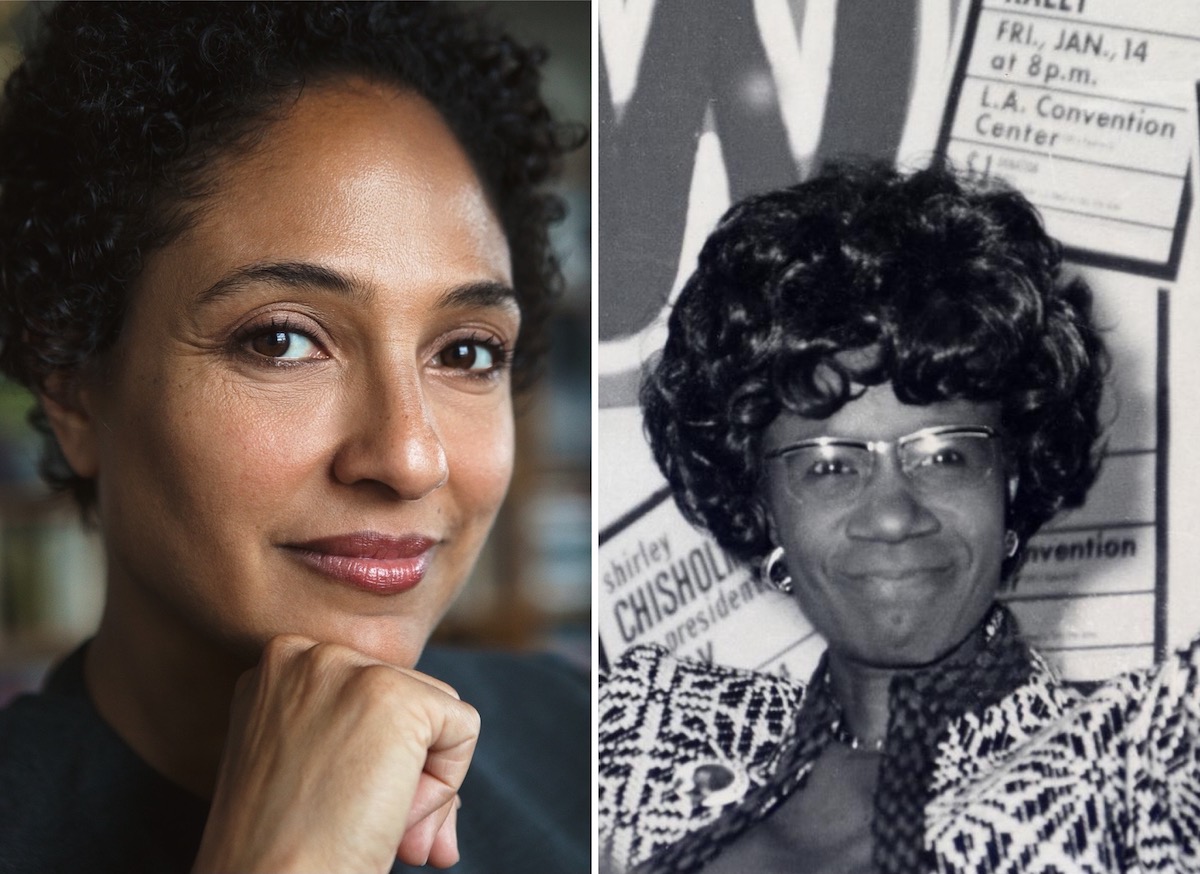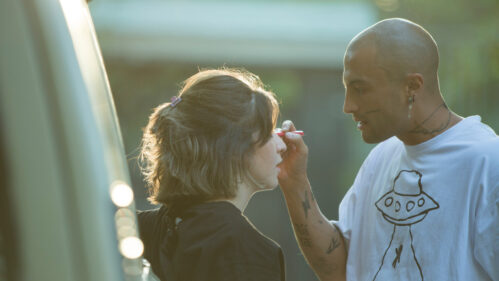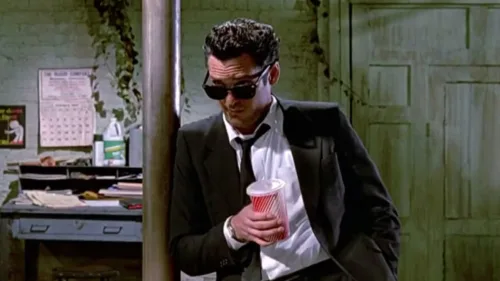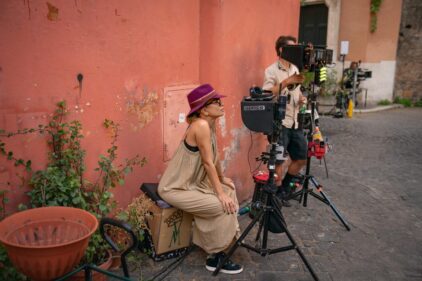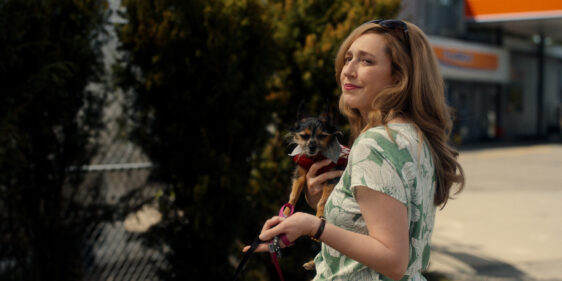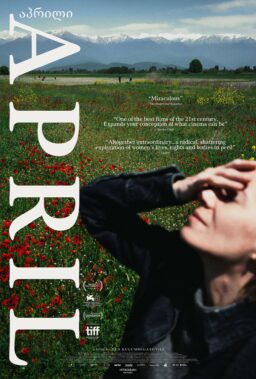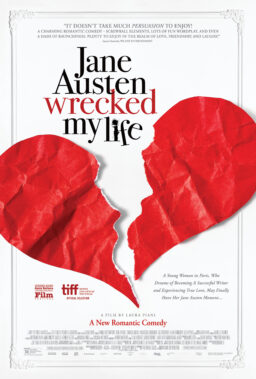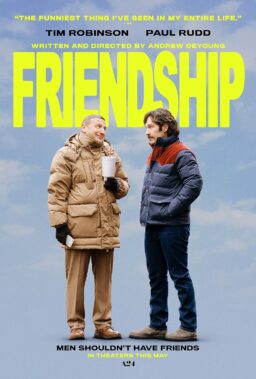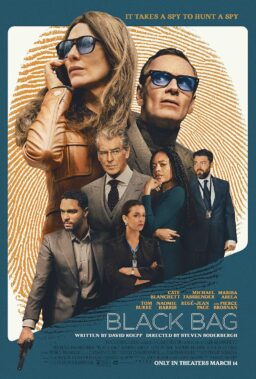There is something about filmmaker Shola Lynch’s laugh that is utterly infectious. I noticed it during her unforgettable interactions with Ernie and Bert in the early days of “Sesame Street,” and was charmed by it all over again during our recent chat on the phone. What could also be deemed as infectious are the spirits of the women whose lives she has explored on film. After watching Uzo Aduba’s Emmy-worthy portrayal of Shirley Chisholm, the first black U.S. congresswoman who made a historic bid for the White House in 1972, on Hulu’s recent series, “Mrs. America,” I was eager to learn more about the political trailblazer’s story. Thankfully, Lynch’s excellent 2004 debut feature, “Chisholm ’72: Unbought & Unbossed,” is currently streamable on Prime Video, and it made me all the more enamored with the courage, wit and bold vision of its titular subject. She was both the first woman to run as a presidential candidate for the Democratic Party, as well as the first black candidate for a major party’s presidential nomination, though her name has been conspicuously left out of most history books. Lynch makes Chisholm’s story come alive through candid interviews, rousing archival footage and a keen eye for nuance.
It certainly helps that Lynch’s own fierce tenacity matches that of her subjects, both in “Chisholm ’72” and her subsequent feature about the iconic activist Angela Davis, 2012’s “Free Angela and All Political Prisoners.” The director is truly an exuberant force of nature, and in her conversation with RogerEbert.com, she discusses the vitality of community, the relevance of Chisholm’s legacy and how Ken Burns and “Sesame Street” shaped her view of the world.
I first heard about your documentary on an episode of the addictive YouTube series, “Be Kind Rewind,” which recommended various films to watch that tied into the historical events portrayed in “Mrs. America.” Do you feel the show has done justice to Shirley Chisholm?
I just started watching the series, and my thoughts are twofold. First of all, her part was clearly written from seeing my film. You could tell by the styles they chose and the footage they selected, such as the Walter Cronkite clip. All of that is very much the same. It just underscores that documentaries help us see ourselves, and that is reflected in narrative work. They didn’t reach out to me, but especially when we are talking about women of color, our imaginations are not that great. [laughs]
I haven’t seen episode three yet, which is the one that focuses primarily on Shirley, but what narrative movies tend to forget about people of color is that we are actually the stars of our own lives. In the first episode of “Mrs. America,” the star of the show is Phyllis Schlafly, and everybody else is tangential to her. Certainly someone like Shirley Chisholm, who she never actually interacted with and probably would not have, is on the extreme fringes of her reality. When I made my documentary about Shirley, I didn’t interview George McGovern or those other big guys because I knew what would happen. I represented them through archival footage, but interviewing them would’ve taken away from my goal of centering Shirley’s story. I wanted to see her point of view about what it was like to be a black woman running for president in 1972.
When did you first become aware of her?
I didn’t really learn about her until college, when I read Paula Giddings’ book When and Where I Enter, which is a history of black women in the United States. It was eye-opening to me because you grow up having this idea of the people that have come before you, but when you can’t name them and you can’t imagine them, it’s not real to you as a young person. What that book did is it named these women and described the journey of their lives in a kind of larger narrative, which is not part of the “regular” American history narrative. When I first read the paragraphs about Shirley Chisholm, I was at the University of Texas in the honors program, but I was mainly at that school because I wanted to be an Olympian. I loved the coach and the track team, so my idea of success at the age of 18 was to win.
I didn’t have a very good or complex understanding of race or gender at this point in my life, so when I read about Shirley running for president, I just thought that it was the most ludicrous thing that you would ever do, and I wrote that in the margins. It wasn’t that I was embarrassed, but it pricked at me in a particular way because I couldn’t completely understand it. Ten years later, when I was looking for what would be the subject for my first feature as a director, I heard Shirley’s birthday being announced on NPR, and I was so happy to hear that she was still alive. Then this lightbulb went off in my head, and I took the Paula Giddings book off the shelf in order to refresh myself about her story. Then I looked at what I had written in the margins, and I was mortified.
What aspects of the years you spent working for Ken Burns’ production company, Florentine Films, guided your first foray into feature filmmaking?
When you are the director, you shape the vision and the story, and there is real power in that. The first projects I worked on for Florentine Films were a documentary about Frank Lloyd Wright, which really didn’t have race in it at all, and the “Jazz” series, which dealt with both race and gender. You have limited time in a documentary—there are no footnotes—and so we would have discussions about how to include certain stories and if they were worth making the final cut. “Jazz” is a man’s story, primarily, though it does feature some women singers. When I thought of myself as a director, I wanted to see what I could do with a different kind of story centering on a woman and a woman of color.
I had a master’s in American History and Public History Resource Management. That was my graduate work, and when I came back to New York City after graduating, there were cutbacks in the arts, so I couldn’t get on a curatorial track. By accident, I landed a job with Ken Burns and Florentine Films, because I knew how to research and they hired me to utilize those skills to assist the writer. So I became introduced to filmmaking through working at his company for four years, and I just loved that you could take these artifacts and weave them together to create stories that compelled people to want to know more about history. It’s like the gateway drug for learning. I felt that I had missed so much that was important about history. It’s the opposite of boring, and is actually like philosophy, in a sense. It raises questions that help you learn about the past but also who you are and the choices you’ve made.
I would love to have seen the historical curation in your master’s thesis, “How Far Have We Come?”, which illustrated how the media has perpetuated racial stereotypes.
When I was curating for walls, it never occurred to me that I could make a film or be a filmmaker. What the experience of working with Ken Burns did for me was it gave me the confidence to see if I could do it. While making “Chisholm ’72: Unbought and Unbossed,” I realized that I had learned so much just by being in the room. It was on-the-job film training, in a sense. I learned about the business and fundraising because you’re in the room with them, so his company is very family-oriented in that way. But what you’re never quite sure of is what you’ll do under the pressure of being the director. It’s so much easier to armchair quarterback other people’s decisions.
My decision to make “Chisholm ’72” was driven partly by my passion for the topic and partly by my need to test myself, which brings it back to the athletics. You’re only as good as your last race. This was going to be my shot as a director, so what I wanted to do was not be timid about the filmmaking. I’m not Ken Burns, so I’m not trying to make a Ken Burns film, I’m trying to make a Shola Lynch film, but what is that? I didn’t know, and it was exciting to figure that out during the process of making the film. There were certain things that I was able to try and do. It was about developing an aesthetic, and you don’t do it alone. You pull together your team, and I had a really great team for that film as well.
Your interview with Chisholm is fantastic. How did you go about preparing for it?
Oh thank you! Well, she had written two books, so I read those as part of the primary research. I also had pre-interviews with everyone, so I didn’t sit down and interview anybody without talking to them first. A lot of this story hadn’t previously been written about, so in a way, this is original scholarship. It is not based on somebody else’s already finished work, and so we were learning and discovering as we went. Though you think you know what the story is, there are twists and turns that aren’t revealed until the last moment, which is the hardest part. Sometimes you don’t even discover them during the interviews. It happens later when you go back because during the interview, you’re learning and listening and trying to get through your questions.
The story point the surprised me the most was discovering that [Congressional Black Caucus member] Ron Dellums had not been the person to put Chisholm into nomination at the convention. He had actually decided to not do that and supported George McGovern without having a conversation with her, and it caused a lot of pain for both of them. Neither one of them talked with me about it, and it revealed itself later once I got all the footage from the convention. Someone else had mentioned it in an interview, and I didn’t catch it, so I had to bring all of that together to figure out what the truth was. Sometimes people forget that there’s footage that serves as evidence, and what the research is about is finding that evidence.
You must’ve felt like a detective uncovering this story.
I did feel like a detective, and Shirley Chisholm did not receive the coverage she deserved. The line of questioning she got from the press was often belittling. They wouldn’t ask, “What’s your platform?”, but rather, “Why are you doing this?”, and, “Who are you going to support when you lose?” These are the questions that came up for her, and I don’t think the other candidates had to deal with that. It you look at her strategy in numbers, it’s so smart, and that gets obscured. She was playing the game like the guys, and some of them were asking her not to play because they felt it wasn’t her turn. She was like, ‘What are you talking about? I’m not going to have that conversation with you. This is the game, this is the playing field, and I am going for it.’
When Chisholm encourages us to ask why the Black Panthers formed, it reminds me of how author Kimberly Jones, in her recent viral video, powerfully articulated why looting occurred during the recent anti-racism protests.
There is so much about black history and a black historical perspective that isn’t new—if you have read about it and are conscious of it. Black Lives Matter is a continuation of the conversation that has happened since Emancipation. It is about overcoming the missing two-fifths in the equation of equality and the “American” perspective. That’s been very difficult to overcome, and what that means is that you are always suspect. Black people understand that because they have been subject to it. Mrs. Chisholm could see that clearly in her time period, and if you look at any time period, there’s going to be people who voice that.
I think if she were in Congress today, she would be active and voicing her opinion regardless of whether or not it was the popular opinion. She would also take heart in the protests and the young folks expressing themselves. I don’t think she would be afraid of that, even if she didn’t agree with it. She started off as a schoolteacher, and I think she always had confidence in the next generation. Now we are talking about a new generation. With the COVID-19 pandemic, the protests and George Floyd being the tipping point of so many people who have been killed by police officers, if we can take this moment and create change, she would be for that. That’s why she got into politics.
Your film and “Mrs. America” also illuminate how Chisholm was even devalued within the women’s liberation movement.
That was, in part, a result of the newness of the feminist movement. I don’t think women had enough confidence in themselves across the board, and here she was, as a black woman, saying that she’s running for the democratic nomination for president. I think that the leaders of the women’s movement wanted to be with a “winner,” someone they were confident would win, so they had the same perspective I had as a naive 18-year-old. Going for who you think should win and can win is not the same as supporting the candidate that supports your issues, and they couldn’t separate that. The black political establishment at that time also had trouble separating that as well. Let’s say both of those entities had backed Chisholm, and they went to the 1972 convention with that amount of delegate force. She might not have been the nominee, but they could’ve really had an impact on the platform in a substantial way. As it is, George McGovern wins, and he’s like, ‘Whatever, see ya! I don’t need you. I’m off to the races, and there’s no way I can’t beat Nixon,’ which turned out not to be true.
Chisholm’s campaign slogan “unbought and unbossed” has been used to describe many subsequent politicians, including the current mayor of Washington D.C., Muriel Bowser.
What that slogan symbolizes is a certain amount of independence that she had to have in order to even be a political player. The sad part is her candidacy would not have been possible today because of corporate interests and the way that the Democratic Party runs itself. You need so much money to run. Chisholm ran campaigns raising a little bit of money and on her savings as a schoolteacher. If you’re a schoolteacher today, you’re not saving. The economic realities have made it so difficult for regular people to participate, so you get career politicians who are playing the game and towing the party line, which prevents the diversity of opinion that we as American citizens deserve. People like Alexandria Ocasio-Cortez are outliers.
Since editors are, in many cases, the co-directors of films, particularly in the case of documentaries, to what extent were you involved in the editing process?
Oh that was essential, first in terms of who we hired. I worked with Sam Pollard, who also edited and produced “Four Little Girls,” which was nominated for an Academy Award. He’s gone on to make narratives and is quite a director, but at the time, he was editing, and one of the things that was really important was capturing Chisholm’s spirit and the spirit of the 70s. Watching footage from that era, you realize that it was a period of experimentation, with split screen and wacky graphics used on the news. Chisholm’s personality is so strong that we had to be sure to capture that as well.
The main thing I wanted to talk about was what each scene meant emotionally and how to collage it, because that’s what editing is. It’s bringing together all these elements so that not just the words resonate, but the feelings resonate, and one of the things that I’ve learned from working on Ken Burns documentaries is that scripting really helps with that. I always write a script for the first draft because it helps everybody kind of galvanize around the main themes, and then the collaboration begins to make that really work as a film. The cut that you have on paper is never the film, it’s usually terrible. [laughs] That sort of preparation gives you something to like or dislike, rather than speak in generalities or theoretically. Editing also costs a lot of money, so you want to maximize your time in the cutting room.
You’ve previously spoken about the importance of pushing past discomfort, just as Shirley and Angela Davis did upon reliving painful memories through your films.
Angela doesn’t like to talk about herself, but in Chisholm’s case, her run for president was remembered in such negative terms that I think she had taken it on as something she did and wanted to forget. The repercussions left some distaste, and she was punished for that, in many ways, so she wasn’t sure what it would be like to go back and revisit it. Some of her relationships were fractured, she was in debt and the IRS came after her, all because she had done something that she thought was just part of her democratic duty. Why couldn’t she, as a black woman, run for president?
She would speak at colleges, and be very straightforward about her views. She was one of the only people who didn’t vote for funding the Vietnam war. Young people loved hearing from her, and they were like, ‘You should be running for president, we want you to be president!’ I think that’s when she was like, ‘Why not?’ [laughs] She really thought that her strategy was a sound one, and not necessarily to win the nomination, but to really impact the platform, because she was accumulating delegate votes. There were no caps in most states, so if you won three percent of the votes, you would win three percent of the delegates. Now there are ten percent and fifteen percent caps.
All kinds of regulations have been put in place after 1972 to keep the number of candidates down, and for them all to be established people due to the amount of money they raised and the amount of votes they received. In 1972, there weren’t any of those rules, and the voting age had changed from 21 to 18, so the expectation was that there would be millions and millions of young people coming out to vote who could really impact the election. I loved when Ron Dellums said, “She’s taking advantage of this historical moment, and why should that scare you?” And it really did scare people because it wasn’t her turn. She was out of place.
It took Shirley a long time to say yes to the interview, and part of that was probably due to her discomfort. I was also a first-time filmmaker, and in fact, what she told somebody else was that I was so persistent in my keeping in touch to prod her into this that she finally just said yes to get rid of me. She never quite thought that I would actually make the film. [laughs]
So she respected your persistence just as you respected her’s, in a sense.
Yes, I would say it came full circle. When the film was completed and it got into Sundance, we had no idea that would happen. It was just one of the most exciting and wonderful moments to be validated in that way. We received most of our funding from grants and PBS, and because it was a film without narration and it had graphics, there were some executives who thought, ‘This isn’t the way that we tell stories.’ After you get into Sundance, people don’t have that fear anymore.
Now that the film is streamable on Prime Video, what do you hope the role of this film could be during this pivotal moment?
There’s something for almost everyone to take away from Chisholm’s story, but in this moment, I think that her ability to be true to herself and to engage fully in her environment, which was a political environment, is a huge takeaway. There are women and women of color who can be reminded of that by watching her. I also think that our political system is broken, and seeing somebody who is so free to be herself, regardless of the criticism, and who builds her community in such a way that her work gets facilitated, is so important. Most people like to think of her as this lone character, but she always had a husband. She was Mrs. Chisholm, not Ms. Chisholm, and she had her friends, her community and her allies who helped support her in the work that she was doing. So she wasn’t out there on her own, and sometimes that’s how we portray people like her in our historical retelling. Having community is a really important component of “paving the way,” as she liked to say.
The reason that the film is available now is because it was funded mostly by grants and it aired on PBS, which means that I own it, primarily. So through Sundance and their support of filmmakers and distribution, I had cleared rights in order for that film to live in perpetuity because it was an important piece of history, and I was able to raise the money to do that. If I had made it for someone else, it would be in their library and they wouldn’t be thinking about it. As filmmakers, especially now, we’re often not able to think about the business side of things, since we are always hustling to make a living. Sometimes we forget about the larger repercussions of the stories we tell and who owns them. I don’t think history should be owned by corporate interests, and that’s one of the things I was able to learn from the Ken Burns school of filmmaking. He’s got a great crew of people at Florentine Films.
You made your first appearance on “Sesame Street” the same year that Shirley Chisholm ran for the presidency. What do you remember about being on the show?
First of all, you’re not acting, let’s just be clear on that. They select kids that interact and are good at make believe and will play along. That’s essentially what it is, so it was a head trip. I grew up in the 70s, so my favorite album was Free to Be You and Me, and “Sesame Street” fits into that. My street cred comes from “Sesame Street,” which is so corny to say. [laughs] It’s a world where we all get along, we do our best and we are trying to build community. I think that show is a sweet reminder of what democracy can look like, and sometimes I think we lose sight of that. We’ve gotten to the point where I wonder what the national community is because we have trouble talking to each other. When we’re kids, we’re actually taught to act and behave in another way. Then we become adults, and we forget everything we’ve learned.
It seemed like puppeteers Jim Henson and Frank Oz empowered your imagination during your interactions with their characters, whether you’re taking a nap, learning about size and weight, or simply cheering them up.
I thought of it as playing. I knew I was playing with my friends, Ernie and Bert, and I knew that they were puppets. I was actually sitting up on a ladder, looking down at the puppeteers, but I got to interact with these characters, Ernie and Bert, and it was a lot of fun just pretending with them. I remember the sets and I do remember Caroll, who played Big Bird, showing me how the puppet worked as well as the camera and other technology inside of it. I also saw him in his bird feet, which came up to his chest. [laughs]
I remember being inside Oscar’s can and Mr. Snuffleupagus, and when I think back to it, the value of the whole experience, and of the show itself, was that it was fun. Both as someone who was part of the production, but also somebody who watched it at home, the show was fun to watch, and that made learning fun. It was colorful and dynamic, and when I was thinking about making my first film, I knew that it was my responsibility to hook viewers into the story and to make them feel something about it. “Sesame Street” and Ken Burns really informed who I am as a filmmaker and how I see the world, and that’s not a bad thing.
Some of the most memorable moments on the show were when the kid’s personality would redirect the sketch. I loved when you imitated Ernie’s laugh.
It wasn’t a documentary because there was a script for the adults, but the kids were not scripted exactly, and they would keep rolling until they got the interaction they were looking for. They would come at you with another question, or come at you with the same question in another way, and I had so much fun with Ernie and Bert. I’m more of an Ernie type, as evidenced by my laugh, and I pretty much married Bert. [laughs] So that relationship is a strong one.
What are you looking to do next?
I run the film and audio archive at the Schomburg Center for Research in Black Culture, so I am helping the library collect and make accessible the voices and movements of black history and culture. The films that I like to make require intense research and it takes time to fundraise because of the way these stories are sometimes valued in the marketplace. This job allows me to empower more people to tell more stories, and I think that is really important. It’s not just me telling stories, it’s more people telling more stories. I am always working on something. I’ve done a bunch of things for the Academy and the Governor’s Awards, and I wrote my first narrative script, which is historical and based on a woman’s life. I just finished working on a piece for ESPN on Florence “Flo-Jo” Griffith Joyner, the sprinter from the 80s, and occasionally I do shorter artsy pieces. Above all, I love to tell true stories.
As a member of the Academy, what are your thoughts on its efforts in recent years to amplify diverse voices through its membership and museum?
I think that the Academy is doing the right thing. The more it reflects society, the more audiences there will be for the films. We have to acknowledge that the reason there aren’t many black filmmakers that we know about is because there was no avenue in for them. They couldn’t get in the union. We have to know that first, and then we can look at what the history of black filmmaking was, which was largely independent. There is a history there and a story to tell. Thirdly, how do we make sure that more voices are included? That comes from not only the filmmakers but the executives. What I would like to say to Hollywood is that we need more diverse executives. I am tired of hearing that there is no audience for a story about Shirley Chisholm or Angela Davis. We know that such claims are not true.
“Chisholm ’72: Unbought and Unbossed” is available to stream on Prime Video. For more information on Shola Lynch, visit her official site.

